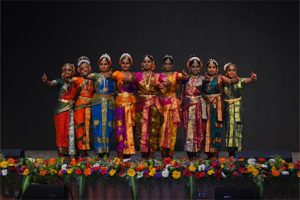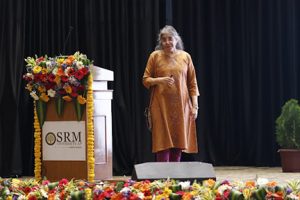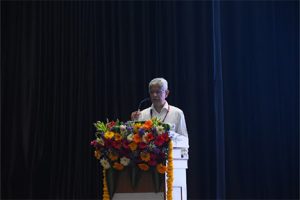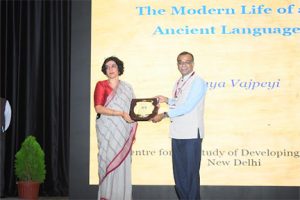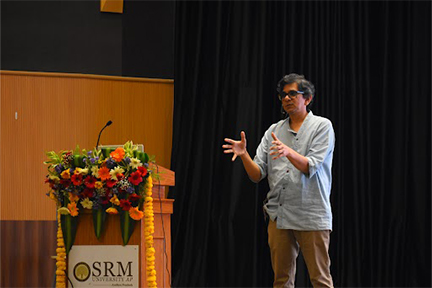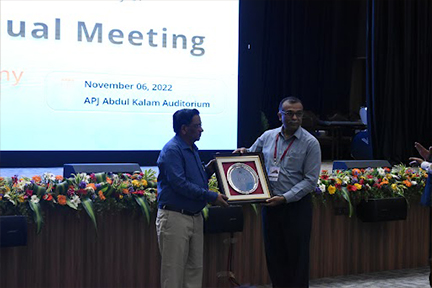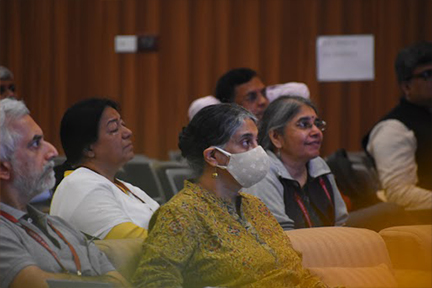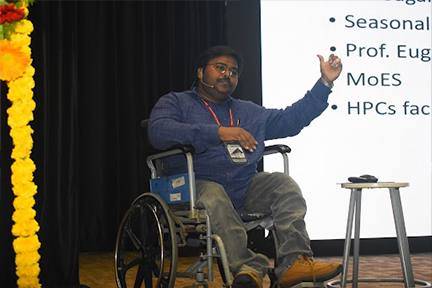The second day of 88th Annual Meeting of Indian Academy of Sciences at SRM University- AP
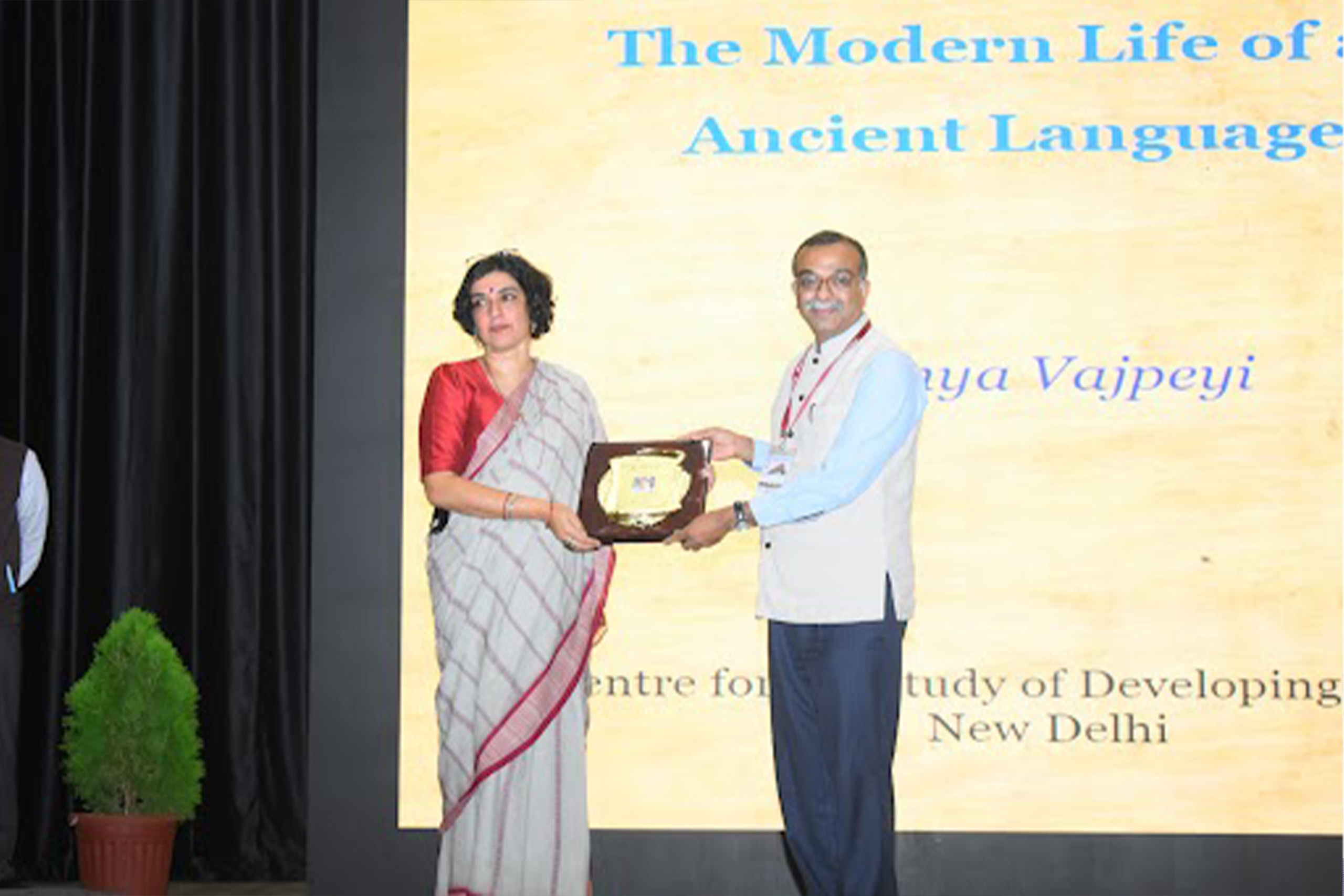
The second day of the 88th Annual Meeting of the Indian Academy of Sciences held at SRM University- AP on Saturday, November 05, 2022, continued to behold the momentum of the first day of the gathering. The highlights of the day were the Lectures by fellows and associates, a Symposium on “Floods in the Anthropocene,” and a public lecture on “The Modern Life of an Ancient Language” by Ananya Vajpeyi, Centre for The Study of Developing Societies, New Delhi.
The first session in the morning, lectures by fellows and associates, was chaired by G V Anand, Dayanand Sagar University, Bengaluru. The series of lectures commenced with a talk on “The Novel (IZ4) spreading code design for NavIC’s LISPS signal” by P Vijay Kumar, IISc, Bengaluru. The lecture focused on the NAVigation with Indian Constellation (NavIC), an indigenous regional navigation satellite system developed by ISRO, and other related topics.
Anil K Tripathi, BHU, Varanasi, did the second lecture on the “Regulatory cascades of alternative sigma factors are involved in controlling rhizocompetence in a plant growth promoting rhizobacterium, Azospirillum brasilense.” The lecture focused on Azospirillum brasilense, one of the most ubiquitous plant growth-promoting rhizobacteria, which can sense and detoxify Reactive Oxygen Species (ROS) released by plants. Furthermore, the talk proceeded to discuss how bacteria respond to changes in their internal and external environment by expressing genes needed to cope with the challenges of the altered environment. The session elaborated on the changes faced in the root zone, the rizhocompitance of plants, the fundamental ways in which the roots respond to changes happening in the roots, the effect of stigma factors, and many more.
Atul Geol, CORI, Lucknow, did his lecture on “Development of donor-acceptor-based fluorescent dyes for diagnostics and biomedical applications.” He detailed the pioneered breakthrough innovations of basic building blocks for synthesising TAQMAN-like probes and alternate conjugation chemistry to develop complete RT-PCR kits for detecting SARS-CoV-2 variants. He also expressed how his team is engaged in developing efficient approaches for synthesising new organic fluorescent dyes with absorption and emission at various wavelengths for biomedical and diagnostics applications.
The Development origins of Health and diseases (DOHaD)) hypothesis suggests that early life exposure, including maternal nutrition and phenotype, can predict the risk of non-communicable diseases (NCDs). The session on “Early life exposure and future risk of non-communicable diseases: Relevance in the Indian context” by GR Chandak, CCMB, Hyderabad, elaborated this hypothesis furthermore. It explained the dissection of gene-gene and gene-environment interaction that can predict the future risk of NCDs.
The lectures by fellows and associates were succeeded by a symposium on “Floods in the Anthropocene.” Introduction to this exciting session was done by the Convener Pradeep P Mujumdar, IISc Bengaluru. He provided an overall idea regarding the title of the symposium. He reflected on the ecological and geographical aspects of the topic. He talked a bit about the repeating patterns of floods, the changing frequency of rains, the effect of reservoir operation on floods, etc.
Rajiv Sinha from IIT, Kanpur, was the first to deliver a lecture in this session and was on the “Hydrogeomorphology and sediment dynamics of floods.” He explained that there are particular settings where floods occur more frequently than in other riverbeds and stated that understanding this can help predict the potential sites of floods. The session discussed relevant topics such as the worldwide distribution of floods, Floods in large rivers, Natural or human-induced reasons for floods, Rivers in the Anthropocene concerning specific reference to flood hazards, geomorphology of rivers, floods, and sediment dynamics, dynamic flood topography and many more. The session also put a thought upon the false sense of security while living close to larger rivers that eventually result in irreversible loss. Moreover, he introduced the idea of integrating river morphology into flood management.
The topic “Extreme precipitation under human-induced climate change” was handled by Subimal Ghosh, IIT, Mumbai. Spatial and temporal resolutions of rainfall, extreme precipitation, thermodynamic and dynamic contributions to changing precipitation, atmospheric instability and precipitation, future changes in different warming levels, impacts of urbanisation, and many other topics were under discussion.
The next session on “Deciphering the role of climate change in floods” by Arpita Mondal, IIT Mumbai, explained how a once-in-a-thousand-year event, flood, became a once-in-10-years event with a detailed analysis of the recent flood emergencies occurred in India. She also stressed the attribution analysis of floods, anthropologic climate change, Spatio-temporal scales to define the event, and many other areas.
The last speaker of the symposium was J Indu, IIT Mumbai, and was centered around the topic “Floods from the vantage point of Radars.” She started the lecture by questioning the inaccuracy of observing precipitation from satellites for examinations. She also inspected the network of weather radars, forecasting using radar-based rainfalls, the time limit of radar data assimilation, etc. The symposium came to an end with an exciting interactive session that raised numerous constructive queries and composed a space for incredible engagement.
The afternoon sessions started with lectures by fellows and associates, and C Pulla Rao from IIT Tirupati served as the chairperson of the series of lectures. “Distinguished varieties in the polydisc and dilation of commuting matrices” by Sourav Pal, IIT Mumbai, set the start of the lectures.
Binod Sreenivasan, IISc Bengaluru, was in charge of the next session on “Understanding Earth’s magnetic reversals.” He conferred about one of the long-standing questions in dynamo theory: whether the preference for the axial dipole is due to a purely hydrodynamic process influenced by planetary rotation or due to a magnetohydrodynamic process influenced by both rotation and the self-generated magnetic field.
The talk “You are what you eat: linking metabolism to physiology & health” by Ullas K Seetharam, TIFR Mumbai, put forward the importance of discovering or understanding diet or metabolism-driven mechanisms that govern psychological homeostasis to tackle the explosive burden of non-communicable diseases.
The session ended with Meena B Mahajan, IMSc Chennai, through her lecture on “What is hard to prove, and why?”. She instructed formal proofs, the design of formal proof systems and demonstrated its limitations.
- Published in News, University Event
The finale of the 88th Annual Meeting of Indian Academy of Sciences at SRM University- AP
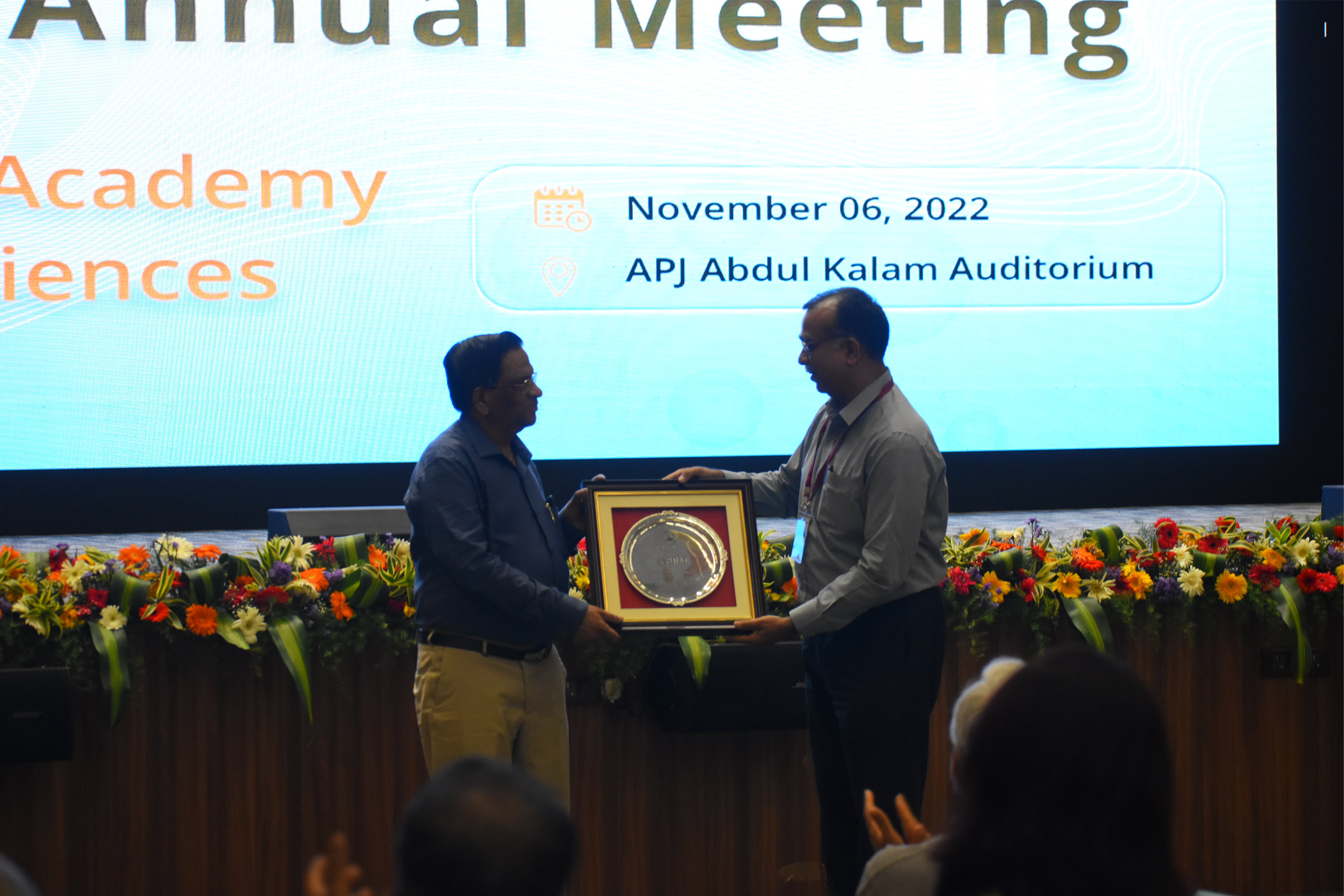
The three-day-long 88th Annual Meeting of the Indian Academy of Sciences came to an end at SRM University- AP on November 06, 2022. On the final day of the Meeting, Dr Swapan K Ghosh, University of Mumbai, chaired the first set of Lectures by Fellows/Associates Dr Prabhat Mandal, SN Bose National Centre for Basic Sciences, Kolkata; Dr Jitendra K Bera, IIT, Kanpur and Dr P Sreenivas, University of Hyderabad, were the speakers.
Dr Pranab Mandal spoke on the topic “A new paradigm for understanding solids”. He briefly discussed the conventional electronic states, which have been realised in the band theory of solids. The theoretical foundation and experimental realisation of topological electronic states in several condensed matter systems were also covered in the lecture.
“Water as a reactant in organometallic catalysis” was the topic presented by Dr Jitendra K Bera. The talk focused on the hydration of nitriles and alkynes, olefin oxygenation, alcohol oxidation to acid, and oxidative deamination of primary amines using water.
The last speaker of the session was Dr P Sreenivas, and he dealt with the topic “An advanced Ensemble Kalman Filter based ocean-atmospheric coupled data assimilation system and its impact in enhancing the Indian monsoon predictions”. He elaborated on how the new system incorporates theoretically advanced features of flow-dependency and ensemble-based analysis, and the predictions using the new system simulate the large-scale monsoon features and convection canters well and improves Indian Summer-monsoon-rainfall prediction skill with a gain of one month lead time.
Dr A Jayaraman, Bangalore University, Bengaluru, was the Chairperson to the lectures by Dr Suchana Taral, Pondicherry University, Puducherry; Dr Gobardhan Das, JNU, New Delhi and Dr Sneha Sagarkar, SP Pune University.
Dr Suchana Taral’s talk was on “Source-to-sink pathway of the Himalayan sediments: New evidence from the eastern Himalayan foreland”. In the lecture, she proposed a new model for the evolution of the eastern foreland basin, taking into account the hierarchical stratigraphic response to eustatic and tectonic forcing.
“Mycobacterium Tuberculosis programs mesenchymal stem cells to establish dormancy and persistence” was the topic presented by Dr Gobardhan Das. He explained that Tuberculosis treatment displays a biphasic bacterial clearance, in which the majority of bacteria clear within the first month of treatment, but residual bacteria remain nonresponsive to treatment and eventually may become resistant. Then he proceeded to show that Mycobacterium Tuberculosis was taken up by mesenchymal stem cells (MSCs), where it established dormancy and became highly nonresponsive to isoniazid, a major constituent of directly observed treatment short course (DOTS).
Dr Sneha Sagarkar talked about “Reward memory recall: Role of Glutamatergic Neurotransmission in the dentate gyrus”. She explained why the reward association process is critical for memory-guided decision-making that deteriorates mental illnesses such as binge eating disorders (BED), drug addiction, and schizophrenia.
The Special Lecture titled “Nobel Prize for Physics 2022: From Foundational Questions in Quantum Physics to Cutting Edge of Today” by Sadiqali Rangwala, RRI, Bengaluru, had V A Raghunathan, RRI, Bengaluru as the chairperson. He discussed the physics problems from first principles and highlighted how the pathbreaking experiments were done, which led to the Nobel Prize.
In the Public Lecture titled “The Modern Life of an Ancient Language”, Dr Ananya Vajpeyi from the Centre for the Study of Developing Societies, New Delhi, revisited the history of Sanskrit in modern times. According to the speaker, Sanskrit finds new life and meaning in a world shaped by nationalism, science, and struggles over identity. Vibrant cultural programmes by the students of SRM AP were also organised as a part of the 4-day long celebration of Science and Technology on campus. IASc President Prof Umesh Waghmare felicitated SRM AP Pro Vice-Chancellor Prof D Narayana Rao for successfully hosting the 88th Annual Meeting of the Academy.
- Published in News, University Event
SRM University- AP hosted the Science and Technology Exhibition of ISRO&DAE
SRM University-AP hosted the Science and Technology Exhibition organised by ISRO & DAE from November 03-06, 2022, as a part of the 88th Annual Meeting of the Indian Academy of Sciences, Bengaluru. The exhibition laid the foundation for scientific discourse in recent developments in nuclear tech, space tech and rocket science. Modern research models and detailed exhibition panels arranged at the tech venue, engaged students with the latest research technologies.
The scientific convention witnessed a prolific participation from school students from the regional locale with almost 20,000 students from various schools like Delhi Public School, S.T.B.E.M. High School etc. attending the event. Students had the opportunity to associate with renowned scholars and researchers and experience the technological advancements in ISRO & DAE space and nuclear tech. They were free to explore the exhibitions under the guidance of student volunteers of SRM AP.
The ISRO exhibition, inaugurated by the Honourable Governor of Andhra Pradesh, Shri Biswabhusan Harichandan, showcased prototypes of satellites/vehicles with a detailed description on their conception, manufacturing and working principles. Exhaustive exhibition panels displayed information on breakthrough space ventures including the Gaganyaan Mission, Mars Orbiter Mission and many others. Chanda, a 9th grader from DPS, commented that she was ecstatic to visit the exhibition and the campus. The young space enthusiast utilised this opportunity to learn about the different models and their application and vocalised her desire to become the next Kalpana Chawala.
Demonstration models illustrating novel nuclear tech and atomic models were the highlights of the DAE exhibition. Followed by the inauguration, the exhibited prototypes were briefly explained by Jalaja Madan Mohan, Head Technical Co-ordinator & Public Awareness Section, IGCAR, DAE to the Honourable Governor and other dignitaries visiting the exhibition. The DAE exhibition provided an incredible opportunity for young students and researchers to explore the evolving domain of atomic and nuclear science.
The enthusiastic and active participation of students were graciously welcomed by Pro Chancellor of SRM AP, Dr P Sathyanarayanan, Vice Chancellor, Prof Manoj K Arora, and Pro Vice Chancellor, Prof D Narayana Rao. The students were dispensed with knowledge about modern technologies and research fields to promote research interest for the progress of society. They were also made aware of the growing career opportunities in the reputed organisations of ISRO & DAE. Lunch followed by a tour of the campus acquainting them with the state-of-the-art facilities were also provided.
- Published in News, University Event
The prevalence of digital divide and agrarian crisis in rural India
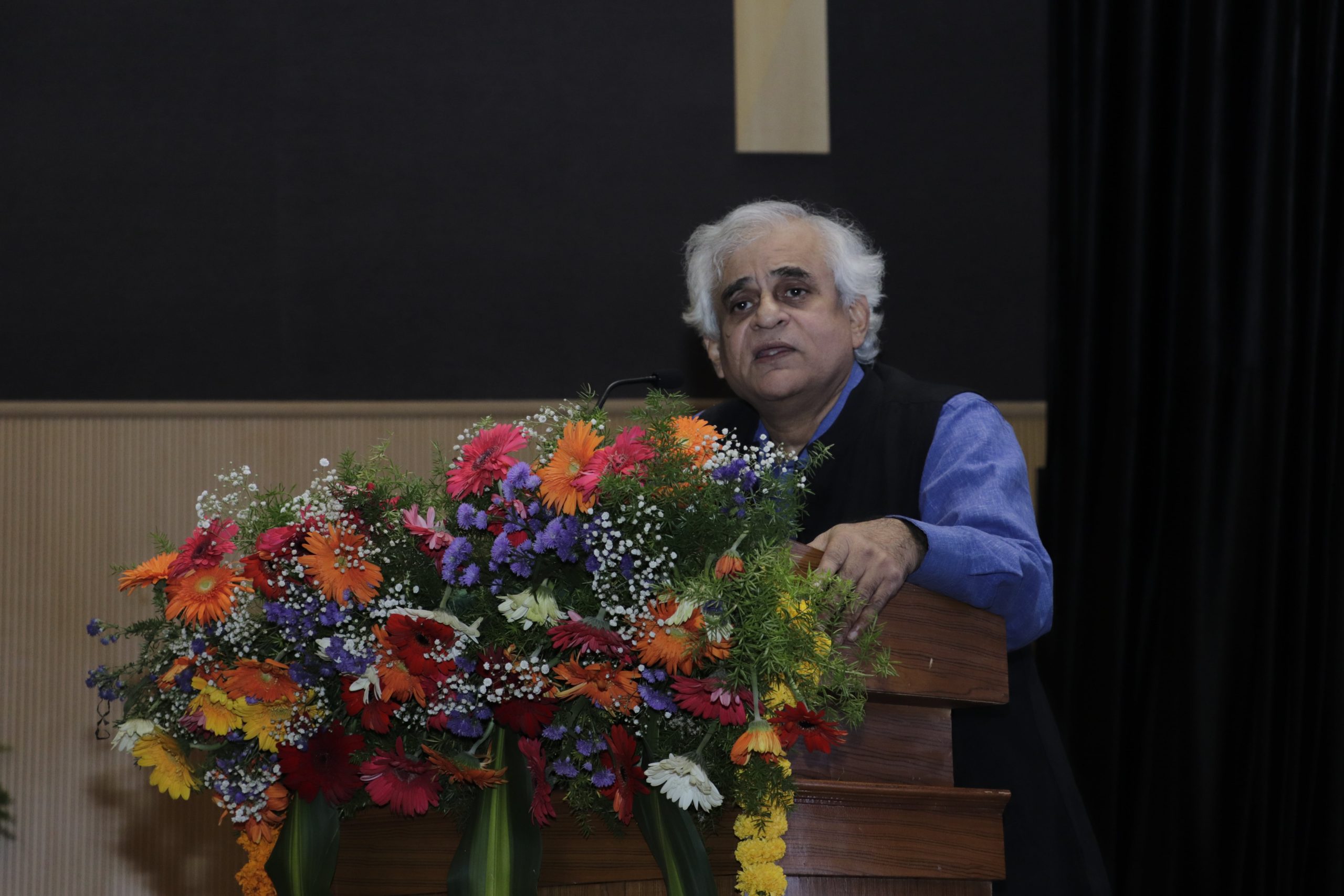 Eminent Columnist P Sainath addressed the gathering of scientists and researchers from various parts of the country in the Public Lecture Telling the stories of rural Indians in the digital age: The People’s Archive of Rural India. The lecture was organised as a part of the 88th Annual Meeting of the Indian Academy of Sciences at SRM University-AP, Andhra Pradesh.
Eminent Columnist P Sainath addressed the gathering of scientists and researchers from various parts of the country in the Public Lecture Telling the stories of rural Indians in the digital age: The People’s Archive of Rural India. The lecture was organised as a part of the 88th Annual Meeting of the Indian Academy of Sciences at SRM University-AP, Andhra Pradesh.
P Sainath talked about the People’s Archive of Rural India (PARI), which brings together science, technology, culture and literature. PARI is a free digital space wholly dedicated to rural India, publishing in 14 languages in India with a huge volunteer force of translators. Though rural India accounts for 69% of the total population of India, their representation in the frontier of national dailies are limited to a meagre total of 0.67 percent. P Sainath commented on this ostracization by calling out the tainted and prejudiced rationale of media houses on neglecting rural life as they offered no credible revenue for their media coverage.
Mr Sainath also talked about the content of his upcoming book The Last Heroes: Foot Soldiers of Indian Freedom expressing that, “It is a gigantic tragedy that this generation and the coming generation won’t be seeing our freedom fighters”. He further talked about the alarming status of India in the environmental performance index and global hunger index and the need to address the agrarian crisis and the growing digital divide in society. “Equitable distribution of opportunities paramount to the democratisation of digital content “, affirmed P Sainath as a concern about online education. IASc President Prof. Umesh Waghmare thanked Mr P Sainath for sensitising the scientific community about the pertinent issues around them.
- Published in News, University Event


